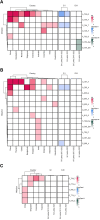Simultaneous Cocirculation of 2 Genotypes of Dengue Virus Serotype 3 Causing a Large Outbreak in Sri Lanka in 2023
- PMID: 39387651
- PMCID: PMC11998561
- DOI: 10.1093/infdis/jiae474
Simultaneous Cocirculation of 2 Genotypes of Dengue Virus Serotype 3 Causing a Large Outbreak in Sri Lanka in 2023
Abstract
Background: We observed a discrepancy between dengue NS1 antigen test and molecular diagnostics, with the emergence of dengue virus (DENV) serotype 3 in Sri Lanka, and sought to understand the cause for the rise in cases and high failure rates of molecular diagnostics.
Methods: Whole-genome sequencing was carried out in 22 DENV-3 samples. Phylogenetic and molecular clock analyses were done for genotype assignment and to understand the rate of evolution. Mutation analysis was done to understand the reasons for polymerase chain reaction (PCR) nondetection.
Results: We identified 2 DENV-3 genotypes (I and III) cocirculating. DENV-3 genotype III strains shared a common ancestor with a sequence from India collected in 2022, while DENV-3 genotype I, was found to share a common ancestor with DENV-3 sequences from China. DENV-3 genotype III was detected by the modified Centers for Disease Control and Prevention DENV-3 primers, whereas genotype I evaded detection due to key mutations at forward and reverse primer binding sites. We identified point mutations C744T and A756G in the forward primer binding sites and G795A in the reverse primer binding sites, which were not identified in DENV-3 genotype III. Furthermore, our Sri Lankan DENV-3 strains demonstrated a high root to tip ratio compared to the previous DENV-3 sequences, indicating a high mutation rate during the time of sampling (2017 to 2023).
Conclusions: The cocirculation of multiple genotypes associated with an increase in cases highlights the importance of continuous surveillance of DENVs to identify mutations resulting in nondetection by diagnostics and differences in virulence.
Keywords: dengue; genotypes; molecular diagnostics; mutations; sequencing; serotypes.
© The Author(s) 2024. Published by Oxford University Press on behalf of Infectious Diseases Society of America. All rights reserved. For commercial re-use, please contact reprints@oup.com for reprints and translation rights for reprints. All other permissions can be obtained through our RightsLink service via the Permissions link on the article page on our site—for further information please contact journals.permissions@oup.com.
Conflict of interest statement
Potential conflicts of interest. All authors: No reported conflicts. All authors have submitted the ICMJE Form for Disclosure of Potential Conflicts of Interest. Conflicts that the editors consider relevant to the content of the manuscript have been disclosed.
Figures




Update of
-
Simultaneous co-circulation of two genotypes of dengue virus serotype 3 causing a large outbreak in Sri Lanka in year 2023.medRxiv [Preprint]. 2024 May 9:2024.05.09.24307112. doi: 10.1101/2024.05.09.24307112. medRxiv. 2024. Update in: J Infect Dis. 2025 Apr 15;231(4):1041-1048. doi: 10.1093/infdis/jiae474. PMID: 38766092 Free PMC article. Updated. Preprint.
References
-
- World Health Organization . Dengue: WHO health emergency appeal 2024. Geneva, Switzerland: World Health Organization, 2024.
-
- World Health Organization . Ten threats to global health in 2019. https://www.who.int/news-room/spotlight/ten-threats-to-global-health-in-.... Accessed 28 March 2024.
MeSH terms
Grants and funding
LinkOut - more resources
Full Text Sources
Medical
Molecular Biology Databases

